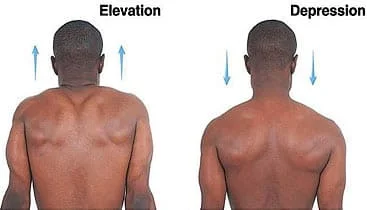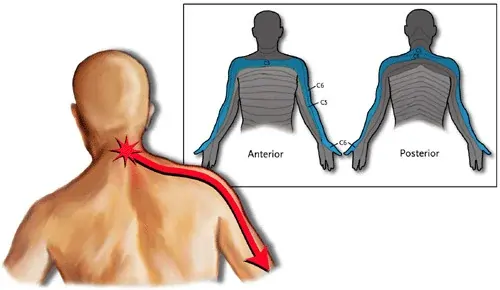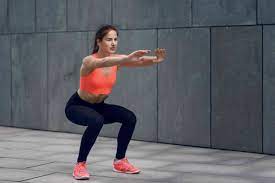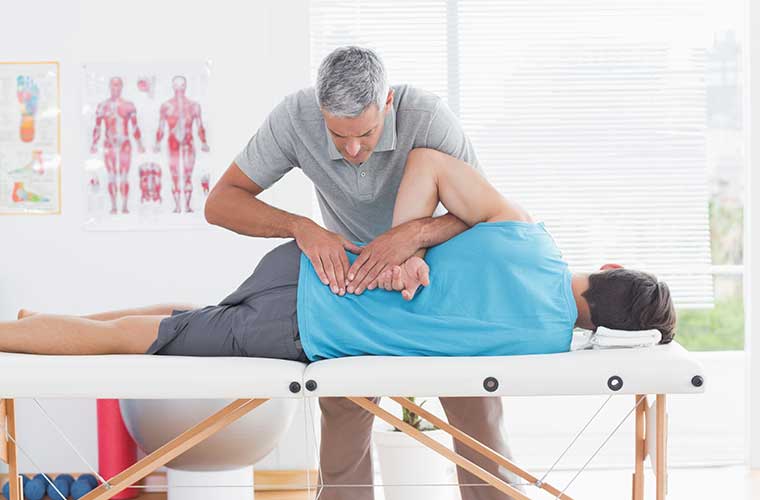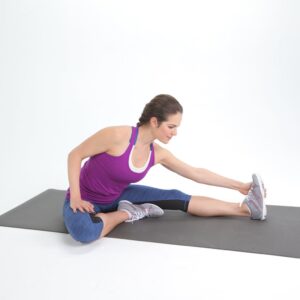31 Best Bicep Workouts for Mass and Strength
The Biceps are two muscles on the front of the upper arm. They are responsible for bending the elbow and rotating the forearm. Biceps mass is important for both strength and appearance.
There are many different exercises that can be used to build biceps mass.
Table of Contents
Introduction
- The biceps is one of the most “famous” muscles in the body. Even when they are young, children raise their arms and flex them towards a mirror or at one another to demonstrate who is more powerful and dominant. When someone asks you to flex, they’re not asking to see your detailed back or ripped chest; they want to see your biceps. There are certain very particular routines that can be done to generate maximal muscle in the biceps. It has long been utilized to determine how much muscle a man has in his entire body.
- certainly, these exercises are less effective when done alone. It is advisable to combine them with a comprehensive exercise program that covers the complete body. As you perform the exercises for building bigger biceps, it’s crucial to keep in mind that no skeletal muscle is more significant than another.
- If your arms are bigger and stronger, you might feel more confident. Chiseled arms can also convey strength and athleticism. But having stronger arms has some significant practical advantages as well.
- Stronger arms make it easier to perform any upper-body task, such as scooping up children or lifting large goods.
- Having additional muscle mass can: In addition to improving your daily functional fitness.
Boosting your metabolism means burning more calories even when you’re not exercising. - Decrease your risk of injury while increasing muscle strength, endurance, and tone
- The two biggest muscles in your upper arm are the biceps in the front and the triceps in the back. Their strength-training routines must be different since they have opposing functioning muscle groups.
- Big biceps are a clear indication to the rest of the world that you have worked out hard. Although the biceps are small muscles, building them takes time, consideration, and careful programming. Not only do large biceps look fantastic, but they also have practical uses. Your biceps are working the next time you pick up your child or complete a flawless pull-up.
- The good news for you is that developing your biceps only requires you to curl repeatedly. And certain workouts work better than others at getting the job done.
- A strong and effective upper body is mostly dependent on having powerful biceps. You can lift and carry objects more easily if you have strong biceps. There are some specific suggestions for the finest biceps training to make the most of your efforts.
A good set of dumbbells, barbells, kettlebells, or other weights is required. Some folks merely employ excessive force. They frequently grasp a barbell or dumbbell that is way too heavy and end up swinging their bodies to lift the weight rather than utilizing a focused action. It merely distributes the work throughout many muscular groups, including the hips, shoulders, and back. The biceps don’t receive a solid exercise when this occurs. - But if the weight is too light, neither strength nor muscular mass will increase.
- Return to the fundamentals and learn how to develop your biceps with the proper weight and exercise regimen to fix this.
Biceps Basics
- From the front of the shoulders to the elbow, the biceps muscles are located. There are two distinct elements to them: a long head and a small head. Both become active during biceps exercises, however, they react to movements differently. The biceps are in charge of shoulder flexion, forearm supination, and, to a lesser extent, elbow flexion (curling the arm up and down).
- Beyond the visual benefits of larger muscles, strengthening the biceps is crucial since they are essential for lifting, pushing, and pulling. The loss of these abilities might be severe as you become older. Other joints and muscle groups, such as the elbows, wrists, forearms, shoulders, and lats, will eventually be affected, which will affect more than just your ability to execute simple chores.
- None of the other arm and shoulder muscle groups can develop to their maximum potential or preserve delicate ligaments, tendons, and joints without a strong core bicep.
How to Work Your Biceps
- A strength routine that is well-rounded should include biceps exercises. Although concentrating only on the biceps could physically seem enticing, doing so will result in an imbalance that could damage the alignment of the shoulders and elbows, making them more (rather than less) prone to injury.
- Tendinopathies in Children are Prone to Imbalances in Muscle and Tendon Development.
- You should always use a weight that allows you to flex and release with isolation (meaning that no other muscle is involved) but is heavy enough to create tiredness at the conclusion of the set because the bicep muscles are proportionately tiny, at least in respect to your chest and back.
Bicep Anatomy
- You should spend some time learning about the muscles you’ll be using and their function in your daily life before beginning any exercise program. When you comprehend how they work, you’ll be able to employ and control those muscles in exercises to get the finest biceps workout possible.
- What Muscles Comprise the Biceps?
The Biceps Brachii, Coracobrachialis, and Brachialis are the three main muscles that make up the biceps.
- Brachii Biceps
This muscle group starts in the process of the scapula (shoulder blade) and is connected to the radius of the forearm. About one-third of the muscular mass in the upper arm is made up of this muscle tissue, which extends the entire length of the front of the humerus (the upper long bone of the arm). - Coracobrachialis
The smallest of the three muscles, this one attaches to both the humerus and the coracoid process of the scapula. This muscle pulls the arm in front of and towards the torso. - Brachialis
This muscle originated in the lower humerus segment and crossed the elbow joint before extending to the ulna. Although the brachialis is a member of the bicep muscle group and is the strongest elbow flexor, it is unable to rotate the forearm because it only inserts on the ulna, not the radius.
Biceps Muscle Function:
- Although the brachialis may be the main elbow flexor, the biceps also play a big part in this. However, it performs a lot more tasks outside just flexing the elbow. This is due to the fact that the biceps cross three joints! Three, indeed! We’ll elaborate.
- Proximal Radioulnar Joint of the Elbow: One of the biceps’ most crucial jobs is to supinate the forearm, which means it turns the palm upward. This is because it has a stronger mechanical advantage because it is anchored farther away on the radial tuberosity. Actually, you’ve probably noticed that when the forearm is pronated (palm down), the biceps are noticeably less prominent. Here’s why. The “A” game of the biceps is supination.
- The biceps’ attachment to the humeroulnar joint of the elbow gives them the ability to flex the elbow. The biceps only function as a flexor, though, when it is supinated. The brachialis and brachioradialis must exert all of the force when the forearm is pronated since the biceps provide little support. This is one of the factors contributing to how weak your reverse curls are.
Shoulder’s Glenohumeral Joint in Forward Flexion: The biceps crosses the shoulder joint in addition to the elbow, as is common knowledge. If you’ve ever wondered why, when doing arm curls, your elbow slides forward, now you know! - Actually, the biceps are responsible for the arm’s forward flexion. Although this is significantly less powerful than its other abilities, you can still train your biceps to use it.
Biceps Training Benefits:
- Biceps exercises are an essential component of any training regimen. It goes without saying that biceps training will result in attractive, large arms, but there is much more to it than that. They also produce muscular, alluring arms. Here are a few more advantages of biceps exercise.
- 1) Improve a healthy physique:
Maybe vanity isn’t over with us yet. Every guy wants large arms, and if you neglect biceps training, that won’t happen. And let’s face it, most individuals probably solely train their biceps for this purpose alone, and there’s nothing wrong or shallow about that. We work out to better ourselves and our bodies, and having slender arms prevents that from happening. Basically, you need to fill up any large gaps in your sleeves.
- 2) Reducing Injury
Injury prevention is an advantage of biceps exercise that many individuals overlook. In fact, elbow flexion is often included in workout routines for building specialized strength merely as a means of avoiding injuries. The biceps and elbow are particularly vulnerable to injury during exercises like deadlifts because of their location. A fantastic way to maintain your arms healthy and injury-free is to have strong biceps.
- 3) Enhance Additional Lifts:
As already mentioned, almost every pulling motion involves the biceps. Therefore, you won’t perform as well on these lifts if you have weak biceps. Not being able to extend your back row because your biceps are wearing out too quickly would be awful. muscular pulling motions result from muscular biceps. We advise going a step further and include workouts that concentrate on the forearms, such as dumbbell forearm exercises. Your ability to lift heavier loads will increase as your arms become stronger.
- Your biceps are a desirable muscle type, at least in your mind. The advantages of strengthening your biceps may seem clear if you’re aiming for round, peaked biceps. But even if a specific look isn’t what drives you, having strong biceps will aid you with your heavier lifts.
- Compound Support Lifts
Strong, muscular biceps are a prerequisite for building a strong, powerful back. You need biceps strength to support all that weight whenever you’re rowing in any manner. - An individual exercising with a barbell while wearing a black shirt.
- During vigorous rows, your back should be performing the majority of the work. However, if your biceps aren’t strong enough to support you, your back improvements will stop before they even begin.
- It’s crucial to build up your biceps in order to support those back-builders. However, they are crucial for powerful pushing actions as well. If you enjoy bench pressing, people will probably pay close attention to your triceps. Develop your biceps to maintain equilibrium in your arms. This equilibrium is essential for preventing harm.
- Fitness That Is Useful
Not all big biceps involve tearing off your shirt sleeves. The ability to lift your children and load your grocery bags into the trunk of your car is made possible by having strong upper arms. - Exercise for your biceps also benefits your wrists and forearms. To be able to maintain your grip over lengthy training sessions that prioritize functional actions like farmer’s carry, you need the muscles engaged in this.
- Physical Conditioning
Training your biceps will help you achieve your large physique objectives in addition to aiding your big lifts. Work your tris if you want thicker arms, but working your biceps will only go so far in allowing your shirt sleeves to enlarge to a certain extent.
Workouts for biceps mass are given below:
Barbell Curl
This technique, arguably the most common biceps workout, can be used to increase both mass and strength.

How to do it:
- Stand shoulder-width apart with your feet shoulder-width apart and your knees slightly bent for balance.
- Use an underhand, shoulder-width grip on a barbell.
- Pin your arms into your sides and resist the urge to move them outward.
- Curl the weight up to your shoulders by bending your arms.
- Reduce the weight and repeat.
- Pro Tip: Try not to lift the weight with your legs or back. Instead, keep your torso erect and your core firm to allow your arms to perform all of the work.
Benefits of Barbell Curl:
- One of the best biceps exercises for building muscle and strength.
- Performing this exercise with an Olympic barbell can help you develop core stability and balance.
Variations on the Barbell Curl:
EZ Barbell Curl
Reverse Barbell Curl
Seated Barbell Curl
How to Incorporate Barbell Curls into Your Workout
The barbell biceps curl should be performed at the start of your arm training routine. If you want to train your back and biceps on the same day, you should do it after you finish your back routine. This exercise should be done in 8-12 reps and 1-4 sets.
Alternating Dumbbell Curl
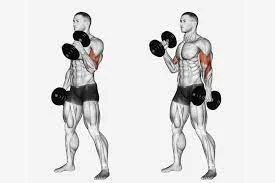
When using dumbbells, you can supinate or turn your forearms while curling the weight. This involves the biceps’ second function and may contribute to increased muscular growth.
How to do it:
- Sit or stand, arms by your sides, with a dumbbell in each hand.
- Thumbs should be pointing forward.
- Bending your elbows will help you curl the weights up to your shoulders.
- Rotate your wrists so your palms face the ceiling as your arms reach 90 degrees.
Lower the weights while unwinding your wrists. - Pro Tip: You can perform this exercise by raising both dumbbells at the same time or by alternating arm movements.
Benefits of Alternating Dumbbell Curl:
- Lifting one dumbbell at a time can aid in the correction of muscle and strength imbalances.
- Dumbbell curls are gentler on your wrist and elbow joints than barbell curls.
- At the top, rotate your pinky outside to focus on your biceps peak.
Dumbbell Curl Variations in Alternation:
Dumbbell Hammer Curl
Dumbbell Reverse Curl
Dumbbell Incline Curl
How to Incorporate the Alternating Dumbbell Curl into Your Workout
Most biceps workouts include dumbbell curls. They are typically performed after the barbell curl, although they can be performed at any time during your session. To maximize hypertrophy, perform 8-12 repetitions and 1-4 sets.
Preacher Curl
This workout isolates your arms and removes the possibility of cheating. It is also known as Scott Curls and was named after old-time bodybuilder Larry Scott, who was famous for his huge biceps.

How to do it:
- Lean over and rest your upper arms on the slanted surface of the preacher’s bench.
- Your arms should be extended to grasp the barbell.
- Bend your elbows and curl the weight up until your forearms are vertical without moving your upper arms off the bench.
- Return the weight to the starting position, pausing just short of full arm extension.
- Pro Tip: You may also execute this workout with a single dumbbell, an EZ bar, or by putting the preacher curl bench in front of a low cable machine.
Benefits of Preacher Curl:
- A must-have in your arm training arsenal if you want to create amazing biceps peaks.
- Eliminates the use of momentum, allowing you to concentrate on your guns.
- Reducing the moving elements helps to build a better mind-muscle link.
Variations on the Preacher Curl:
Cable Preacher Curl
Incline Bench Dumbbell Preacher Curl
Dumbbell Hammer Preacher Curl
How to Include the Preacher Curl in Your Workout
The barbell preacher curl has a place in biceps training. It’s a wonderful isolation workout that will help you challenge yourself, and it will complement your other biceps training routines quite well.
Cable Curl
Cable curls are an excellent substitute for free weights. They have a tendency to keep your biceps tense throughout the range of motion. Free-weight biceps workouts, on the other hand, have “dead spots” when the stress on your muscles disappears.
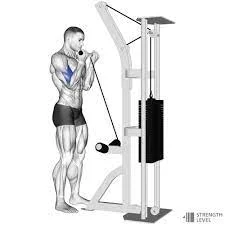
How to do it:
- Connect a low cable machine to a straight or EZ bar.
- Tuck your upper arms into your ribs and grab the handle. Bend your knees a little bit for stability and balance.
- Bend your arms and curl the weight up to your shoulders without bending forward or back.
- Repeat with your arms extended.
- Pro Tip: You can also execute this exercise with one arm at a time if you use a D-shaped handle.
Benefits of Cable Curl :
- Cable exercises are quite useful for adding to supersets.
- It aids in maintaining steady tension on your pythons throughout their range of motion.
- Training with cables reduces the danger of harm.
Variations on the Cable Curl:
Cable Rope Hammer Curl
Cable Reverse Curl
EZ Bar Cable Curl
How to Incorporate Cable Curl Into Your Workout
Cable curls can be done at the start of a workout to pre-exhaust your biceps, in the middle, or at the finish to burn out your target muscles. To get the most out of this exercise, use advanced training tactics such as drop sets, supersets, and intraset stretching.
High Cable Curl
The cable crossover curl workout is similar to a bodybuilder’s double overhead biceps stance. Because most cable crossover machines have mirrors, this exercise is ideal for monitoring your biceps development.
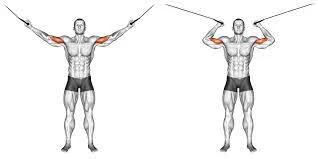
How to do it:
- Place yourself in the center of a cable crossing machine. Set the pulleys to the maximum setting.
Grab the handles by reaching out and up. - Curl your hands towards your head and bend your arms.
- Repeat with your arms extended.
- Pro Tip: This practice is nearly impossible to cheat at. Use mild to moderate weights to achieve a good pump.
Benefits of High Cable Curl:
- A wonderful exercise for mastering the front-double biceps position.
- Aids in the development of the biceps peak.
- It provides a muscle-ripping pump.
High Cable Curl Variations:
Cable Curl
Lying Cable Curl
Machine Preacher Curl
How to Incorporate a High Cable Curl into Your Workout
High cable curls (or overhead cable curls) are typically performed as a finisher at the end of a biceps training session. For best results, perform 3-4 sets of this exercise to failure.
Barbell Reverse Curl
Reverse curls engage not only your biceps but also your forearms and the brachioradialis, a muscle found right beneath your biceps. This muscle lifts your biceps, making your arms appear larger.
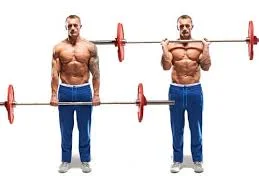
How to do it:
- Use an overhand, shoulder-width grip to hold a barbell.
- Put yourself in a standing position with your knees slightly bent and your feet shoulder-width apart. Tuck your upper arms towards your sides and hold them there throughout the set.
- Curl the weight up to your shoulders by bending your arms. Straighten your wrists.
- Reduce the weight and repeat.
- Pro Tip: You can also execute this workout with a low cable, dumbbells, or a preacher curl bench.
Benefits of Barbell Reverse Curl:
- In addition to biceps, the barbell reverse curl helps create larger and tougher forearms.
- It improves your grip, which helps with compound lifts like the deadlift and clean and jerk.
Variations on the Barbell Reverse Curl:
Dumbbell Reverse Curl
Crossbody Dumbbell Curl
EZ Bar Reverse Curl
How to Incorporate a Barbell Reverse Curl into Your Workout
Reverse curl exercises should be saved for the second half of your workout because they can stress your grip strength and impair your performance in subsequent exercises. To pound your forearms, do 15-20 reps and 3-4 sets.
Cheat Curl
Usually, cheating is a bad idea while trying to gain strength and bigger muscles, but in this case, it works!

How to do it:
- With an underhand grip, take hold of an EZ bar or barbell.
- Curl the weight up to your shoulders by supporting it with your back and legs.
- Slowly and carefully lower the weight. Concentrate on lowering it with impeccable form.
Restart and continue. - Pro tip: You can use more weight than normal with this curl variation. To maximize the increased support offered by your legs and back, make sure to increase your weights by roughly 10%.
Benefits of Cheat Curl:
- You can lift more weight than usual, which may promote growth.
- You can fix your flaws using cheat curls.
Cheat Curl Variations:
Barbell Curl
Cable Curl
How to Set Up Cheat Curl for Workout
Cheat curls should be performed early in your workout while you’re still alert and able to safely lift higher loads. To maximize strength growth, perform 3-5 sets of 1–5 repetitions.
Zottman Curl
The great biceps-building workout known as the “Zottman curl” combines two exercises. Your biceps and forearms will benefit from this exercise.
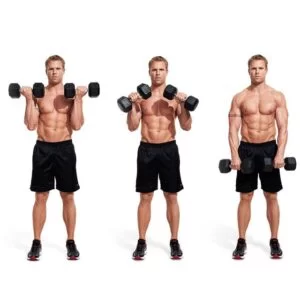
How to do it:
- Standing with your arms at your sides and a dumbbell in each hand. Face your legs with your palms.
- Bend your arms as you raise the weights to your shoulders. Turn your wrists so that your palms are facing down at the peak of the motion.
- Keeping your palms facing the floor, lower the weights.
- Do another rep after turning your hands back to face your legs.
- Pro tip: Alternating arm movements are another way to perform this exercise.
Benefits of Zottman Curl:
- The Zottman curl is one of the few exercises that can effectively engage both your biceps and forearms at the same time.
- It increases the size of both your upper and lower arms and strengthens your grasp.
Zottman Curl Variations:
Dumbbell Curl
Reverse Dumbbell Curl
How to Programme the Zottman Curl in Your Workout
It is ideal to perform the Zottman curl in the midst of your workout. They already provide enough stimulation, so you don’t need to combine them with any other forms of exercise. Do 3–4 sets of 8–12 repetitions.
Chin-Up
The majority of exercisers mistake the chin-up for a pull-up. Pull-ups require an overhand hold, whereas chin-ups require an underhand grasp. An underhand grip will cause your biceps to contract and give you a painful pump.

How to do it:
- Hold onto a pull-up bar with an underhand grip that is shoulder-wide.
- Squeeze your biceps and bring your torso to the overhead bar while keeping your elbows pinned.
At the top, pause and tense your biceps. - Reps are performed by repeating from the starting position.
- Pro Tip: A narrower grip will activate the biceps peak whereas a wider grip will engage the shorter biceps head.
Benefits of Chin-Up:
- If you have access to a pull-up bar, this bodyweight biceps exercise may be performed anywhere.
- The chin-up is a practical exercise that raises your efficiency in other workouts and everyday tasks.
Chin-Up Variations:
Underhand Inverted Row
Lying Cable Curl
How to Include Chin-Ups in Your Exercise
A terrific compound (multi-joint) exercise that is frequently performed at the start of an upper-body workout is chin-ups. To smoke your guns, you might also perform them as the second exercise in a superset. Perform 3–4 sets of 8–12 repetitions.
Dumbbell Hammer Curl
A wonderful workout for the biceps brachii, brachialis, and brachioradialis is the dumbbell hammer curl. It can aid in developing longer, sturdier, and thicker arms.
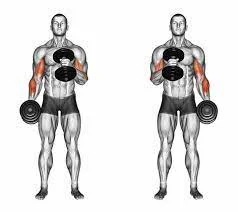
How to do it:
- Grab a dumbbell with a neutral grip (palms facing inward) while standing up straight.
- Keep your elbows close to your sides as you curl the dumbbells to your shoulders.
- At the peak, pause and tighten.
- Once more, repeat.
- Pro Tip: To further concentrate on each side, you might also execute alternating dumbbell hammer curls. The outside of your guns will be the focus of a dumbbell curl to your body’s midline, whereas the short biceps head will be the aim of a dumbbell curl to the outside.
Benefits of Dumbbell Hammer Curl:
- Most people find that the hammer curls are easier on your joints than the traditional dumbbell curl.
- It promotes the growth of larger, thicker arms.
Dumbbell Hammer Curl Variations:
Cable Rope Hammer Curl
Alternating Dumbbell Curl
Dumbbell Reverse Curl
How to Include Dumbbell Hammer Curls in Your Exercise Programme
At any time during your arm workout, perform 3–4 sets of 8–12 repetitions.
Incline Curl
The incline curl is one of those workouts that appears simple, but by the end of the first set, you’ll be pleading for mercy. Depending on your training goal, you could execute the incline curl with a supinated or neutral grip.
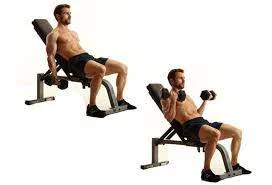
How to do it:
- Place an inclined bench at a 45-degree angle to the ground.
- Lie on the bench while holding a dumbbell in each hand.
- Throughout the entire workout, your shoulders, upper back, and lower back should be on the back pad.
- Curl the dumbbells to your shoulders while maintaining your pinned elbows.
- Restart and continue.
- Pro Tip: Keep your head firmly planted on the back pad the entire time to make the workout more difficult.
Benefits of Incline Curl:
- By removing momentum, this exercise improves biceps isolation.
- It aids in the development of larger, thicker upper and lower arms.
Incline Curl Variations:
Cable Curl
Lying Cable Curl
Machine Preacher Curl
How to Plan Your Workout to Include Incline Curls
The inclination curl is a very rigid exercise. It can be used to pre-exhaust your muscles at the start of an exercise or at any other time. Perform 3–4 sets of 8–12 repetitions.
Lying Cable Curl
A biceps workout that is underutilized is the laying cable curl. It has a unique design, and when doing this workout, your arms almost feel weightless. It is an essential tool in your biceps exercise toolbox.
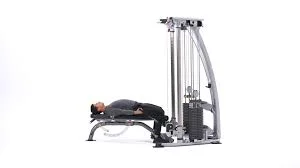
How to do it:
- A straight bar should be connected to a pulley and set at shoulder height.
- Lay on the floor with your forehead under the bar as you grasp it with an underhand supinated grip.
When starting, your arms should be parallel to the ground. - To your forehead, curl the bar. Squeeze your pythons and pause at the bottom.
Repeat after me. - Pro tip: Throughout the ROM, keep your upper arms parallel to one another. Your biceps will relax if you raise your elbows.
Benefits of Lying Cable Curl:
- This exercise isolates your biceps in a novel way.
- You’ll get a muscle-ripping pump without putting too much strain on your joints.
Lying Cable Curl Variations:
Cable Curl
Machine Preacher Curl
Drag Curl
How to Incorporate the Lying Cable Curl in Your Workout
For a pump that tears muscles, finish your session with a laying cable curl. Use a weight that causes you to fail after 8 to 12 repetitions.
Arnold Curl
A list of biceps exercises would be incomplete without mentioning Arnie. In the cult classic film Pumping Iron (1977), the governor demonstrated an advanced variation of the concentration curl. Since then, it has been a staple of every bodybuilding nerd’s workout routine.
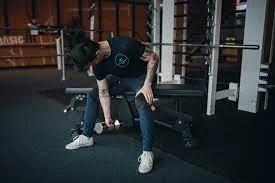
How to do it:
- When standing upright, your feet should be shoulder-width apart.
- Keep your knees slightly bent and hinge at the hips so that your body is virtually parallel to the floor.
- While extending your right arm towards the floor, support yourself by placing your left hand on your left quad.
- Your right hand should be perpendicular to the floor and should be holding a dumbbell.
- Pro tip: Curl the dumbbell while keeping your elbow pinned until your lower arm is parallel to the floor.
Benefits of Arnold Curl:
- It helps isolate your biceps better because your arm is extended between your legs in front of your body.
Arnold Curl Variations:
Lying Cable Curl
Preacher Curl
Spider Curl
How to Plan Your Workout to Include the Arnold Curl
In this workout, you will have to raise very little weight because your arm is not at your sides. Choose a weight you are able to lift for 8–12 repetitions. Perform this exercise 3–5 times.
Facing Away Cable Curl
Fitness fans are becoming more and more enamored with the facing away cable curl, also known as the behind-the-back cable curl. The brachialis muscle is more effectively isolated during this exercise because your elbows are placed behind your torso.
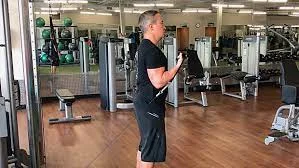
How to do it:
- A functional cable trainer’s pulleys should be adjusted to the lowest position, and D-handle bars should be attached to both ends.
- Face aside from the machine and supine grasp the bars.
- Make a forward movement. The wire should be taut in the beginning position with your elbows behind your torso.
- Curl the grips to your chest level while keeping your elbows tucked up at your sides.
- Pro Tip: The best way to improve forearm engagement is to use a thicker handle or install Fat Gripz to the bar.
Benefits of Facing Away Cable Curl:
- The behind-the-back cable curl increases the size and thickness of the biceps.
- Your biceps experience consistent strain throughout the whole range of action.
Facing Away Cable Curl Variations:
Lying Cable Curl
Cable Curl
Machine Preacher Curl
How to Programme Cable Curls Facing Away in Your Workout
A heavy lift will knock you off balance and pull you towards the direction of the cable machine. Use a lightweight and concentrate on contracting your biceps during each rep. Perform 12–15 repetitions in 3-5 sets.
Concentration Curl
Concentration curls are one of the best workouts for isolating your biceps. This exercise allows you to concentrate on each bicep individually, as the name suggests. This can assist in enhancing your mind-muscle link, which is essential for muscle growth.
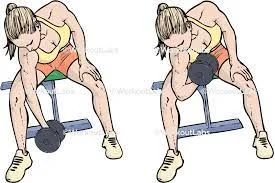
How to do it:
- Sit on a workout bench with one hand on a dumbbell.
- Place your upper arm against the inner of your thigh as you lean forward. Allow the weight to descend to the ground.
- Bend your elbow and curl the weight up to your shoulder while keeping your arm against your inner thigh.
Repeat with the other arm. - Pro Tip: Use your non-working arm to aid you so you can squeeze out a few more reps until you hit failure. This is a type of self-awareness.
Benefits of Concentration Curl:
- The concentration curl eliminates the utilization of momentum, allowing you to isolate your biceps more effectively.
- This puts you in a good position to work through the entire range of motion of your biceps.
- Reduce your chance of injury by avoiding going too heavy on this workout.
Variations on the Concentration Curl:
Preacher Curl
Cable Curl
Overhead Cable Curl
How to Incorporate a Concentration Curl into Your Workout
Concentration curls are typically performed at the end of a workout. The onset of exhaustion makes lifting heavy more difficult, and you must focus on maintaining proper form and contracting your muscles throughout the range of action to get the most out of this exercise.
Crossbody Dumbbell Curl
Crossbody dumbbell curls work both your biceps and forearms. They also work your biceps from an odd angle, which may aid in muscle growth.
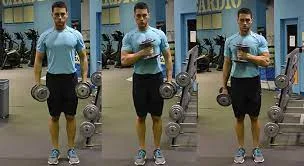
How to do it:
- Stand with a set of dumbbells in each hand.
- Curl the weight across the front of your body and up to your opposing shoulder by bending one arm.
- Lower the weight and then repeat with the opposite arm.
- Alternate your arms for the remainder of your set.
- Pro Tip: This exercise is a great substitute for regular and alternating dumbbell curls. To add diversity to your arm training, substitute it with this exercise.
Benefits of Crossbody Dumbbell Curl:
- The crossbody dumbbell curl works on your biceps brachii, brachialis, and brachioradialis, allowing you to create bigger and thicker biceps and forearms.
- It is an excellent workout for strengthening the outside of your upper arms.
Variations on the Crossbody Dumbbell Curl:
Dumbbell Hammer Curl
Cable Rope Hammer Curl
Alternating Dumbbell Curl
How to Incorporate the Crossbody Dumbbell Curl into Your Workout
The crossbody dumbbell curl can be done at any time during the workout. To get the most bang for your buck, perform 3-4 sets of 8-12 reps with a complete range of motion.
Drag Curl
This intriguing curling exercise was a favorite of legendary 1970s and 1980s Hollywood bodybuilding coach Vince Gironda.
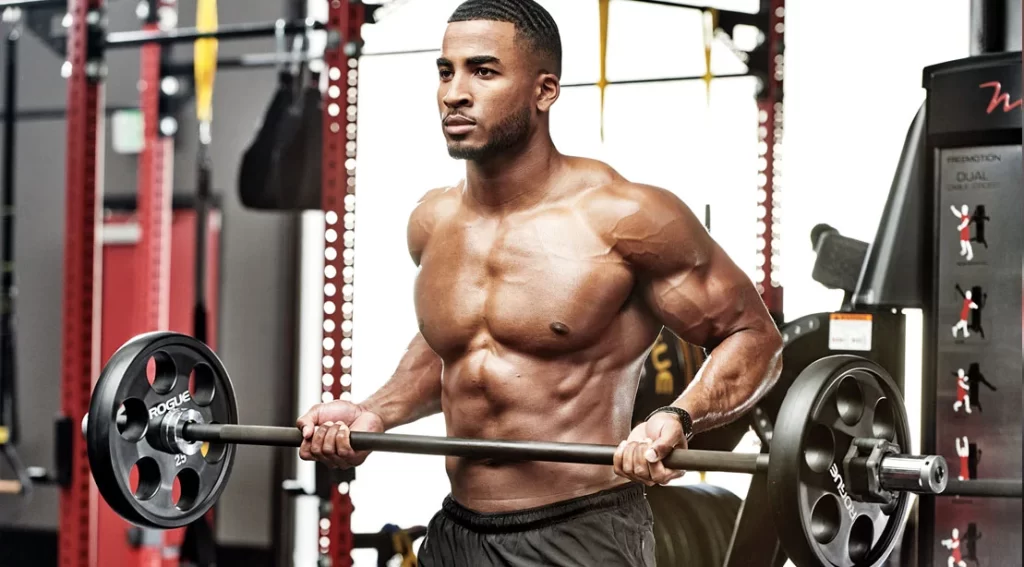
How to do it:
- Hold a barbell at shoulder width with an underhand grip.
- Bend your arms and curl your bar up your front until it touches your lower chest.
- Maintain as close to your body as possible with the bar. As you raise the weight, pull your elbows back.
Reduce the weight and repeat. - Pro Tip: This exercise is far more difficult than conventional biceps curls. Use a lighter-than-usual weight to ensure you can complete the exercise without cheating.
Benefits of Drag Curl:
The drag curl is gentler on your wrists and elbows than the traditional barbell curl.
It is extremely efficient at stimulating the biceps peak.
Drag Curl Variations:
Dumbbell Drag Curl
Smith Machine Drag Curl
Cable Drag Curl
How to Include a Drag Curl in Your Workout
To encourage muscular growth, perform 3-4 sets of 8-12 reps of this exercise. Combine these with cable exercises to completely destroy your pythons.
Spider Curl
This workout is similar to preacher curls, except instead of immobilizing your upper arms, it immobilizes your complete upper torso.
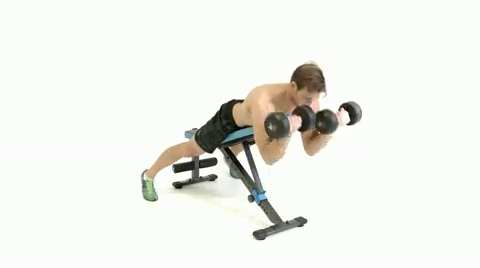
How to do It:
- Set an incline bench at a 45-degree angle to the floor.
- Lie down on the bench with your arms hanging down towards the floor. Each hand should hold a dumbbell.
- Curl the weights up towards your shoulders by bending your arms.
- Repeat by slowly extending your arms.
- Pro Tip: You may also perform this exercise using a barbell or an EZ bar.
Benefits of Spider Curl:
- Helps isolate your biceps by removing momentum.
- This workout uses a barbell to target your biceps peak by stimulating your lengthy biceps head.
Spider Curl Variations:
Preacher Curl
Overhead Cable Curl
Cable Curl
How to Include a Spider Curl in Your Workout
Maintain strict form during this exercise. Maintain an 8-12 rep range and do this activity while you’re fresh. At the end of your workout, combine the spider curl with a resistance band exercise for a muscle-ripping pump.
TRX Suspension Curl
Instead of using cables or free weights, this exercise makes use of braces and your own body weight. For this exercise to be done correctly, your core must be active the entire time.
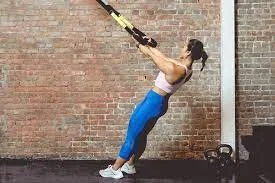
How to do it:
- A high anchor point should be used for the TRX.
- In a supinated grip, take hold of the handles and step backward a few paces.
- Lean back till your arms are out in front of you while keeping your heels firmly on the ground.
- By bending at the elbows, draw your upper body towards your hands.
- Biceps: Tighten them up at the top.
- Repeat from the starting position.
- Pro Tip: To add more resistance as you grow better at this workout, consider wearing a weighted vest.
Benefits of TRX Suspension Curl:
- In addition to producing bigger, stronger biceps, this exercise also strengthens the curl.
- Injury risks are low because this is a bodyweight workout.
TRX Suspension Curl Variations:
Lying Cable Curl.
Machine Preacher Curl
Drag Curl
How to Plan Your Workout to Include TRX Suspension Curls
This exercise can be performed at any time during a home workout by athletes. But those who go to the gym should do this at the start or the finish of their session. Make 3-5 sets of 15-20 repetitions.
Towel Biceps Curl
This exercise calls for a kettlebell or a dumbbell in addition to a towel. The towel biceps curl will help you develop forearms and biceps that are thicker and bigger.
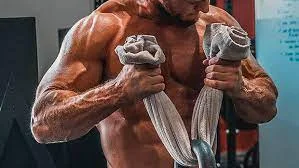
How to do it:
- Wrap the towel around the handle of the weight.
- With palms facing one another, take hold of the towel’s ends in a neutral grip.
- Maintain an erect, shoulder-wide posture.
- Curl the weight until your hands are at shoulder level while keeping your elbows close to your sides.
- Return to the beginning.
- Repeat.
- Pro Tip: To improve forearm engagement, fake grasp the towel.
Benefits of Towel Biceps Curl:
- This exercise improves forearm and bicep engagement.
- The towel biceps curl will assist in strengthening the core and enhancing stability because the weight will be moving during the workout.
Towel Biceps Curl Variations:
Arnold Curl
Preacher Curl
Spider Curl
How to Plan Your Workout to Include Towel Biceps Curls
Any time during the workout, you could perform the biceps curl. Lifters in the intermediate and advanced levels should concentrate on lifting heavy. 3–4 sets of 10–15 repetitions are the ideal.
21s
The 21st biceps exercise on this list is called the 21s 21s. Is it a coincidence or a genius move? Decide for yourself.
One of the best biceps workouts to get a muscle-tearing pump is the 21s. It entails executing seven repetitions in the lower, seven in the higher, and seven in the whole range of motion.
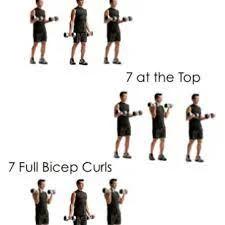
How to do it:
- Hold a straight bar with a supinated grip while standing straight up.
- Curl the bar until your arms are parallel to the ground while maintaining your elbows tucked in at your sides. until the angle is zero, reduce the angle. In this ROM, repeat for a total of seven times.
- When you’ve finished the seventh rep, curl the bar up to shoulder height so that your lower arms are parallel to the ground.
- Lower the bar gradually until your lower arms are parallel to the ground. Perform seven repetitions.
After the seventh rep is finished, go back to the starting position.
Perform seven complete reps. - Pro tip: If the straight bar is too severe on your wrists and elbows, use an EZ bar.
Benefits of 21s:
- You can exercise your biceps over their whole range of motion.
- The best biceps stimulation is provided by the 21s.
21s Variations:
Drag Curl
Cable Curl
Spider Curl
How to Plan Your Workout to Include 21s
For a muscle-tearing pump, finish your workout with the 21s. Use a lightweight to make sure you maintain the proper form because you’ll be exhausted. This exercise should be done three times before stopping for the day.
Strict Curl
A rigorous curl is a necessity in a workout program if you want to develop bigger, stronger biceps. Fast gaining popularity is the stringent curling competition.
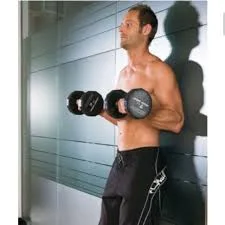
How to do it:
- Take hold of an EZ bar with a broad supinated grip.
- Return to the wall. Throughout the range of motion, you must maintain contact with the wall with your head, shoulders, upper back, and butt.
- Your heels must be no closer to the wall than 12 inches.
- To reach shoulder height, bend the bar.
- At the peak, pause.
- Return to the starting position gradually.
- For each rep, repeat.
- Pro tip: You can move your wrists and upper arms as much as you like, but you have to keep your feet still the entire time.
Benefits of Strict Curl:
- By removing momentum, the strict curl properly stimulates your biceps.
- Always look out for the referee’s cues during a competition to ensure a clean rep.
Strict Curl Variations:
Concentration Curl
Preacher Curl
How to Set Up Strict Curl for Workout
The strict curl should be scheduled in the midst of your workout. Before attempting a one-rep maximum, master the lift because this is a tight movement.
Resistance Band Biceps Curl
For those who practice at home, the next five exercises on this list will completely change the game. Contrary to popular belief, resistance bands can be used to construct respectable pythons.
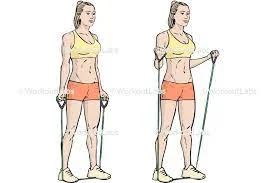
How to do it:
- Lay a resistance band with loops on the ground.
- Stand in the middle of the band with your shoulders spread wide and wrap each end around your hands.
With your elbows tucked in at your sides, curl your hands up to your shoulders. - Repeat after me.
- Pro tip: To make sure you have nothing left in the tank when you get closer to failure, switch to alternating curls.
Benefits of Resistance Band Biceps Curl:
- It produces a strong pump while lowering the chance of injury.
- Throughout the range of motion, resistance bands maintain a continuous strain on your target muscles.
Resistance Band Biceps Curl Variations:
Resistance Band Hammer Curl
Resistance Band Preacher Curl
Resistance Band Concentration Curl
How to Plan Your Workout to Include Resistance Band Biceps Curls
The resistance band biceps curls can be done at any time throughout an arm workout by people who train at home. This should be used as the second exercise in a superset by lifters who work out in a gym to completely destroy their guns. Make 3-5 sets of 15-20 repetitions.
Resistance Band Preacher Curl
No, a preacher bench is not necessary for this workout. You only need your legs.
Make sure your elbows are pinned in place while you complete this exercise to get the most benefit for your money.
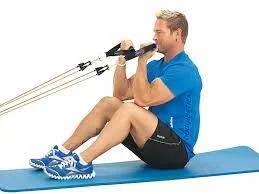
How to do it:
- Tie a loop resistance band’s one end around a heavy item, such as a cable pulley pole.
- Supinated grip with both hands to grasp the other end.
- Put your feet flat on the ground and take a seat there.
- Your upper arms’ base should be on your knees.
- Curl the band while keeping your elbows pinned so that your lower arms are parallel to the ground.
- Return to the beginning. For each rep, repeat.
- Pro tip: To make the band shorter, loop it once before putting it around your foot.
Benefits of Resistance Band Preacher Curl:
This exercise improves your focus on your biceps, stimulating them more effectively. An excellent superset exercise.
Resistance Band Preacher Curl Variations:
Resistance Band Biceps Curl
Resistance Band Hammer Curl
Resistance Band Concentration Curl
Programming Resistance Band Exercise with Preacher Curls
Anytime during your workout, perform this exercise for 3-5 sets and 15-20 reps.
Resistance Band Concentration Curl
This resistance band exercise is more challenging. For optimal benefits, complete this exercise in a calm, controlled motion.
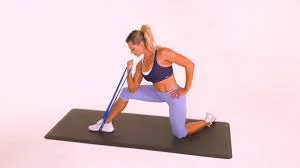
How to do it:
- One end of a resistance band should be wrapped around a substantial object, such as a pole.
- Face the pole with your left side as you stand.
- A supinated grip is used to hold the other end.
- As you bend forward, keep your shoulders broad and your torso nearly parallel to the ground.
- On the inside of your left knee, place your left elbow.
- The band should now be at shoulder height.
- At the peak, pause.
- Continue for reps before alternating sides.
- Pro Tip: To prevent the band from rubbing against your shins, place your hand just in front of your lower leg.
Benefits of Resistance Band Concentration Curl:
- Because it is a unilateral workout, the resistance band concentration curl helps isolate your biceps more effectively.
- Exercises with resistance bands are easier on your joints than those with free weights or wires.
Resistance Band Concentration Curl Variations:
Resistance Band Biceps Curl
Resistance Band Hammer Curl
Resistance Band Preacher Curl
Programming Resistance Band Focus Curl During Your Workout
To smoke your guns, superset the resistance band concentration curl with the resistance band biceps or hammer curl. Perform 3-5 sets of 15-20 reps.
Resistance Band Hammer Curl
The hammer curl targets the brachialis and brachioradialis in addition to the biceps brachii, unlike all the other resistance band workouts on this list.
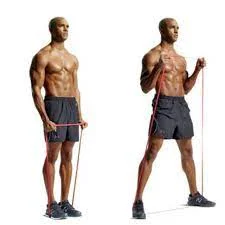
How to do it:
- Grab each end of the band with a neutral grip (palms facing inward) while standing in the middle of the band with your shoulders spread wide.
- With your elbows tucked in at your sides, curl your hands up to your shoulders.
- Repeat as many times as advised.
- Pro Tip: For extra resistance, hold the band closer to the middle. Longer pauses at the top will better stimulate your biceps.
Benefits of Resistance Band Hammer Curl:
- They increase the size and thickness of the biceps and forearms.
Resistance Band Hammer Curl Variations:
Resistance Band Biceps Curl
Resistance Band Preacher Curl
Resistance Band Concentration Curl
How to Plan Your Workout to Include Hammer Curls with Resistance Bands
3-5 sets of 15-20 reps should be performed throughout your arm workout.
Underhand Bent-Over Barbell Row
Despite being predominantly a back workout, a few adjustments can increase biceps involvement. For larger guns, use a supinated (underhand) grip.

How to do it:
- Supine your shoulders and grasp a barbell.
- To virtually parallel with the floor, push your hips back and lean forward.
- Pull the bar to your belly button while contracting your biceps and keeping your elbows tight to your sides.
For each rep, repeat. - Pro tip: If you feel more back engagement when executing this exercise, raise your body higher.
Benefits of Underhand Bent-Over Barbell Row:
- A complex exercise that works your biceps is the barbell row.
- It is a drag-curl modification that makes your firearms more efficient.
Bent-Over Underhand Barbell Row Variations:
Drag Curl
Spider Curl
Preacher Curl
Programming Underhand Oblique Barbell Row During Exercise
You should perform this compound exercise first in a workout because it is a compound exercise. Perform 3–5 sets of 8–12 repetitions.
Underhand-Grip Inverted Row
You must draw through your arms when performing the supinated-grip inverted row, which helps you concentrate on your biceps brachii muscle.
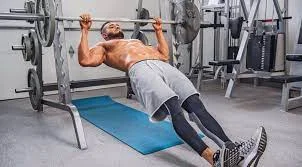
How to do it:
- Place a barbell at waist level in a squat rack.
- Put your upper abs under the bar while lying supine on the floor.
- With an underhand grip that is shoulder-wide, grab the bar.
- Your torso should be off the ground at the starting position, and your body should be aligned in a straight line from head to heels.
- Pull your chest to the bar while tightening your biceps and keeping your elbows tucked down at your sides.
- Repeat after me.
- Pro tip: As you grow better at this workout, raise the bar higher. A weighted vest could increase the challenge further.
Benefits of Underhand-Grip Inverted Row:
- This low-impact workout helps develop bigger, stronger biceps.
- Your biceps’ endurance and strength may be enhanced.
Underhand-Grip Inverted Row Variations:
Drag Curl
Underhand Bent-Over Barbell Row
Preacher Curl
How to Plan Your Workout to Include Underhand-Grip Inverted Rows
During your workout, perform the underhand-grip inverted row. Perform 3–5 sets of 8–15 reps.
Underhand-Grip Lat Pulldown
The underhand-grip lat pulldown is infamous for Python stimulation while being largely a back workout. For bigger, stronger biceps, include this in your exercise routine.
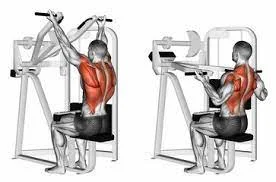
How to do it:
- Adjust the leg pads on your legs.
- With your underhand grip spaced about shoulder-width apart, grab the bar.
- To pull the bar to your shoulder, keep your body straight.
- All the way through the range of motion, contract your biceps.
- Repeat after me.
- Pro tip: Be sure to adhere to the rules strictly. Back involvement will increase as you swing back and forth.
Benefits of Underhand-Grip Lat Pulldown:
- The underhand-grip lat pulldown has the advantage of working your biceps through their complete range of motion, which provides the best stimulation.
- Your firearms remain under steady tension from the cable the entire exercise.
Underhand-Grip Lat Pulldown Row Variations:
Underhand-Grip Inverted Row
Underhand Bent-Over Barbell Row
Preacher Curl
How to Plan Your Workout to Include Underhand-Grip Lat Pulldowns
To get the most out of this exercise, do it in the initial half of your workout while you’re still fresh. Perform 3–5 sets of 8–12 repetitions.
Waiter Curl
An unused biceps workout that helps you tone the lengthy bicep heads is the waiter curl. To increase the size of your biceps peak, do intense waiter curls.
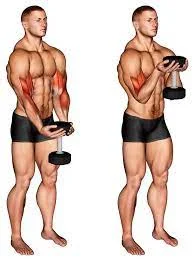
How to do it:
- Supinated, place your hands flat beneath the upper plate of a dumbbell.
- Hold the dumbbell in front of your thighs while maintaining an erect, shoulder-width stance.
- Curl the dumbbell to your chest height while keeping your elbows close to your sides.
- At the peak, pause and tighten your pythons.
- Pro Tip: Make sure you’re not grasping the plate, expert advice. Hold the dumbbell in your hands like a waiter would a platter.
Benefits of Waiter Curl:
- Reduces your grip power, allowing you to concentrate more on your biceps.
- It lessens the possibility of damage because it involves lifting one dumbbell with both hands.
Waiter Curl Variations:
Zottman Curl
Crossbody Dumbbell Curl
Dumbbell Hammer Curl
How to Implement the Waiter Curl into Your Workout
A wonderful finisher exercise is the waiter’s curl. For the best biceps pump, finish your workouts with 3-5 sets of 12–15 reps.
Biceps T Curl
The biceps T curl was popularised by bodybuilding legend CT Fletcher. The incline bench used for this exercise helps isolate the short biceps head.
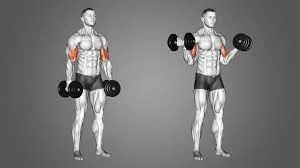
How to do it:
- The incline bench should be angled at a 45-degree angle with the ground.
- In each hand, take a dumbbell.
- So that your arms are straight, place your elbows at your sides.
- Slowly extend your arms while maintaining a flat back, shoulders, and head position on the back pad.
- Your upper arms should be parallel to the ground when you curl the dumbbells.
- For each rep, repeat.
- Pro tip: This exercise is difficult. On the biceps T curl, use 50% of the weight you used for the dumbbell biceps curl.
Benefits of Biceps T Curls:
- They assist you in getting better short-head separation.
- Biceps T curls increase the size and thickness of your arms.
Biceps T-Curls Variations:
Incline Curl
Spider Curl
Facing Away Curl
How to Include Biceps T Curls in Your Exercise Programme
Exercises like biceps T curls are difficult. For a pump that will rip your muscles, perform these towards the finish of your workout. 3–5 sets of 8–12 reps should be done.
Bicep Building Tips
Follow these basic guidelines while creating a fitness routine:
- Work your biceps three times per week on non-consecutive days. This implies taking at least one day off between bicep workouts.
- Lift larger weights and execute six to eight repetitions if you want to gain muscular mass. The remaining few reps should be difficult. If they aren’t, you should start lifting bigger weights. Rest between sets for 60-90 seconds. Rep three to four times.
- Use a lesser weight and complete one to three sets of 12 to 16 reps with at least one day of recovery in between if your aim is endurance and lean muscle.
- Switch up your workouts for the best results. Do not repeat the same routines during each session.
- Whether you’re training for muscular mass or endurance, the last few reps should be challenging. If they aren’t, you need to gain weight.
- When lifting and lowering the weight, keep the movement moderate and controlled. When it comes to biceps muscle development, the lowering or eccentric phase is just as crucial as the lifting or concentric phase.
Key Variable For Biceps Training
- Training the biceps is actually quite simple because you exercise them even when you’re not doing out. What? For obvious reasons, when people think of “bicep training,” they naturally think of curls, such as concentration curls, and this is not a mistake. However, you are training your biceps every time you perform a pulling exercise. Chin-ups, barbell row, and dumbbell row are all options. You even work your biceps during face pulls!
- The point is that most individuals overlook this feature and instead concentrate on smaller moves. The issue is that you can’t apply such a large load to the biceps utilizing merely curls. As a result, you should include large compound workouts that are more bicep-specific in your training. Choose chin-ups instead of pull-ups, for example.
- Brett Contreas, for example, conducted an impromptu experiment at his home, comparing dozens of pulling exercises and how they engaged muscles. During weighted chin-ups, he discovered that the biceps were the most activated! To clarify, this experiment involved a variety of arm curls!
- That being stated, here are some things to keep in mind when working on your biceps:
A) Use a Variation Of Biceps Exercise:
As previously said, include other bicep-focused exercises besides arm curls. Choose large compound lifts that will hammer the biceps harder. This involves utilizing a supinated (underhand) grip whenever possible. Perform your rows, for example, with an underhand grip.
B) Use a Range Of Loads:
As said previously, you should employ a variety of loads during your training. This is best done with compound motions, although lesser loads can also be used with compound movements. You’d be correct if you thought this was guidance for every other muscle. The biceps are simply another muscle.
C) Use Variability In Your Training:
As mentioned previously, the biceps are a two-headed muscle that crosses three joints. As a result, in order to fully train the biceps as a whole, you must incorporate diversity into your exercise. When we train biceps, we prefer to incorporate diversity into the smaller workouts on a regular basis. In other words, your larger compound exercises will remain the same, while the smaller exercises will incorporate different perspectives and stimuli.
D) Use Different Grips:
Experiment with different grips even within the same exercise. To exercise the biceps completely, you must strike the brachialis and brachioradialis, which means you must utilize a pronated and neutral grip. As a result, this isn’t so much a suggestion as it is a must. In addition, you can experiment with neutral and wide grips.
E) Train at Least Twice a Week:
For best results, train your biceps at least twice a week. According to research, this appears to be the best amount of training for hypertrophy and growth. However, you might train your biceps three times per week. This could be as simple as adding some extra isolation work after your leg days or when you train the triceps.
- A few words on nutrition
Although the appropriate exercises are essential for developing bigger, stronger arms, you cannot overlook the importance of nutrition. You should also focus on consuming the correct meals to enhance muscular building.
You may limit the results of your arm-building workouts if you don’t provide your body with the necessary nutrition.
When striving towards bigger arms, keep the following in mind:
Increase your protein intake. Protein increases muscle growth and aids in post-workout recovery. High-protein foods to consider include eggs, salmon, chicken breast, tuna, lean beef, turkey breast, Greek yogurt, beans, and chickpeas. A daily protein intake of 1.4 to 1.8 grams per pound of body weight is recommended for muscular building.
Increase your intake of complex carbohydrates. Complex carbohydrates, like protein, are necessary for muscular growth. These carbohydrates provide energy and nourishment to your body. Whole-grain bread and pasta, oats, quinoa, brown rice, potatoes, corn, and green peas are all good choices.
Simple carbs should be avoided. While most simple carbohydrates are high in calories, they provide no nutritional benefits. They’re frequently referred to as “empty” carbohydrates. Sugary drinks, baked goods, candy, cookies, and other sugary treats should be avoided.
Concentrate on good fats. If you don’t get enough fat in your diet, your body may begin to burn protein instead of fat for energy. Olive oil, salmon, peanut butter, and avocado are all good sources of healthful fats.
Don’t skimp on the calories. Make sure you get enough calories from your food. You will most likely not notice effects from your arm-building routines if your calorie intake is too low. Try to meet your calorie demands with nutritious carbohydrate, protein, and fat sources, as well as fresh fruits and vegetables.
- Wrap-up Biceps Workout
Consider this biceps workout more of a concept than a precise program. We mentioned a plethora of elements and strategies to consider when training the biceps, which are sometimes disregarded in other programs. Here’s a quick rundown of the most crucial biceps training variables.
Use complex motions that target the biceps.
Even with solitary workouts, use a variety of loads (6-12+).
Exercise and grips should be varied.
Always include the reverse and neutral grips.
Exercise The Biceps With Progressive overload
Aside from that, train hard, eat well, sleep well, and get some new clothes because your sleeves are ready to burst.
- How to Work Your Biceps
Your biceps are a rather tiny muscular group. When creating your arm training program, keep the following points in mind:
Warm-Up
Many weightlifters make the mistake of starting their workout as soon as they walk into the gym. Failure to warm up your target muscles raises your chances of damage. If you do too much too quickly, your biceps are especially prone to tears.
Spend 5-10 minutes stretching your biceps and upper body to ensure proper blood and oxygen flow to the target muscles. You might also do 3-5 mild sets of exercises in your routine to warm up your joints, tendons, and ligaments.
Balance
Every lifter has a favorite exercise that they tend to repeat in their training. Repeating the same movements again and over can lead to a plateau. To prevent hitting an overhead ceiling, you must continually vary your workout regimen.
A good biceps workout should include both free weights and cable movements. To achieve general development, you should train your biceps from various perspectives. Include both exercises that you excel at and those that you struggle with. Crying movements indicate a weakness that is preventing your biceps from inflating.
Reps and Sets
Your biceps workout sets and reps will be determined by your training goals. Here’s how they should appear:
3-5 sets of 8-12 repetitions for hypertrophy
4-5 sets of 6-8 repetitions for strength
3-5 sets of 15-20 repetitions for endurance
Frequency of Training
Going overboard with your biceps workouts can be detrimental. Because your biceps are a small muscular group, they require more recovery time than larger muscles such as your quads. You must wait at least 72 hours before resuming the biceps workout. Furthermore, persons with a balanced physique only need to exercise twice a week.
When performing pulling exercises, keep in mind that your biceps are also engaged. In your back training day, your firearms are the secondary muscular groups. After a back day, wait 48 hours before training your pythons.
- Tips for Biceps Exercises
Internalize the following biceps training approaches to avoid missing out on gains:
Maintain a Full Range of Motion
To get the most bang for your buck, whether you’re training for hypertrophy, strength, or endurance, or utilizing a machine or free weights, you must use a full range of motion. Restricting your range of motion can cause muscular weakness in a certain range, increasing your risk of injury.
Keep Your Elbows Still
The majority of biceps workouts are isolation movements, which utilize a single joint and target a particular muscle group. Keeping your elbows pressed to your sides allows you to isolate and stimulate your biceps more effectively.
Drop your ego at the door
The biceps are most lifters’ favorite muscle area to train. However, some trainers allow their egos to take over and utilize more weight than they can properly handle. Going too heavy not only increases the danger of injury but also impedes your results.
Use a Strict Method
If you have to swing your torso back and forth to lift the weight, you’re punching above your weight class. Using momentum shifts strain away from your biceps and onto your shoulders and back.
- The Advantages of Biceps Training
Although most lifters aren’t convinced that they need to train their guns, we’ll go through the motions. The following are the advantages of biceps training:
Enhances Compound Lifts
Biceps workouts are generally made up of isolation exercises, which help improve muscular size and strength for compound movements. Pulling multi-joint motions, such as the deadlift, bent-over row, seated row, and so on, necessitate biceps engagement. Compound lifts can benefit from stronger biceps.
Improves Daily Activity Performance
Stronger biceps can increase your effectiveness in daily duties such as lifting grocery bags, holding your children in your arms, and moving furniture, in addition to pulling heavy weights in the gym. Arm workouts also help with grip strength. If you work your biceps hard enough, you’ll get inundated with requests to open jammed jar lids.
Aesthetics
This is the primary reason why most individuals exercise their arms. Jacked arms make you stand out and add to the attractiveness of your physique. Big arms are a mark of power and masculinity; including these 31 exercises in your workout routine will help you attain them.
FAQs
What Are the Best Biceps Exercises for Mass?
The finest biceps-building routines include workouts that you’ll look forward to all week. Lift heavy, then finish with a pump to provide your biceps with everything they need to grow.
Should I do three biceps exercises?
How to Work Your Biceps for Maximum Results
Choose three to four distinct biceps exercises to perform for three sets of 12 reps when creating a routine. You can also execute them as part of a circuit, one bicep exercise after the other with no break in between. You’ll need to go lighter for this, but you’ll definitely feel the burn.
Do biceps grow quickly?
It usually takes 6-8 weeks for you to notice improvements in the appearance of your arms. Around the 12-week mark, you may usually expect to see more noticeable changes, especially if you didn’t previously have a lot of muscle growth in the area!
What is the ultimate bicep exercise?
Curl with a Barbell
This is the king of all arm exercises, as each rep works the entire biceps area. Make sure you start with a shoulder-width undergrip and that your arms are nearly straight at the commencement of the curl. During the movement, do not lean forward or back.
References:
1 Top 5 Exercises For Increasing Bicep Mass. (2023, June 24). Top 5 Exercises for Increasing Bicep Mass – Hustling Club. https://hustlingclub.com/2023/06/24/top-5-exercises-for-increasing-bicep-mass/
2 How Many Times A Week Should You Workout Biceps? (2023, April 16). KLFitness. https://faq.keleefitness.com/how-frequently-should-you-exercise-your-biceps-each-week/
3 The 31 Best Biceps Exercises For Building Bigger and Stronger Guns (Workouts Included) 2022 Updated – Fitness Volt. (2020, January 27). Fitness Volt. https://fitnessvolt.com/best-biceps-exercises/
4 How to Get Bigger Arms Fast: Ultimate Workout Plan (2023). (n.d.). How to Get Bigger Arms Fast: Ultimate Workout Plan (2023). https://origympersonaltrainercourses.co.uk/blog/get-bigger-arms
5 How to Work Your Biceps Smartly for Faster Results. (2023, May 1). Verywell Fit. https://www.verywellfit.com/getting-your-best-biceps-1229816
6 SET, S. F. (n.d.). The Ultimate Bigger Biceps Workout. SET FOR SET. https://www.setforset.com/blogs/news/biceps-workout
7 How to Get Bigger Arms: 8 Best Exercises for Biceps and Triceps. (n.d.). How to Get Bigger Arms: 8 Best Exercises for Biceps and Triceps. https://www.healthline.com/health/exercise-fitness/how-to-get-bigger-arms


